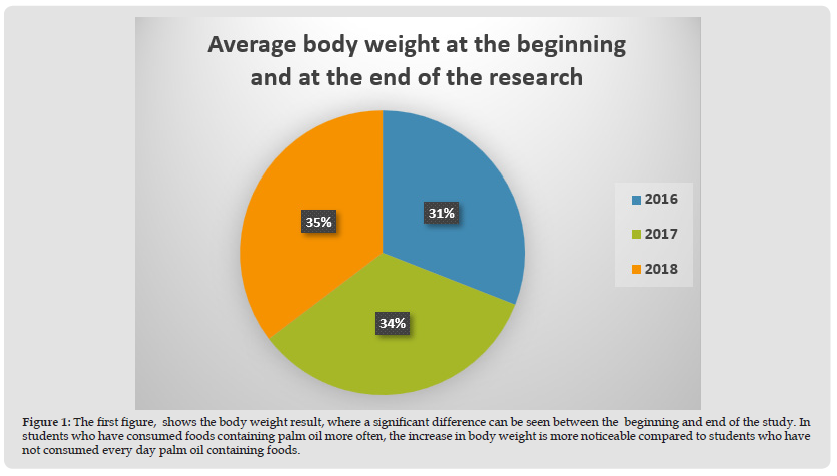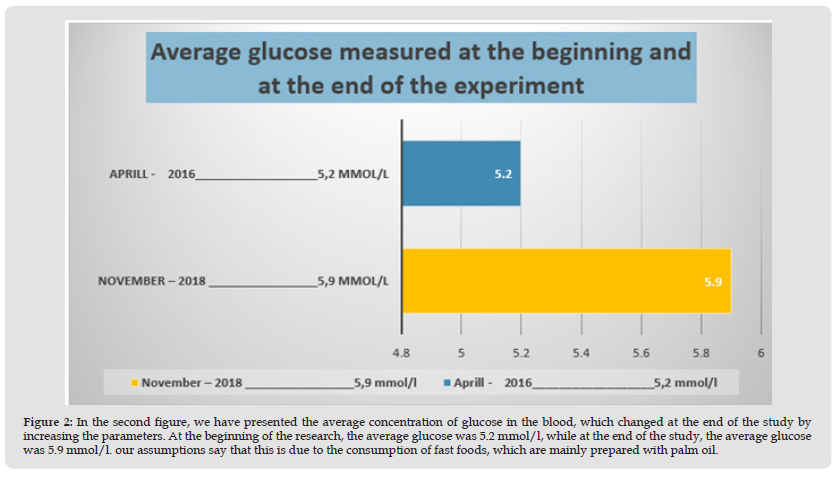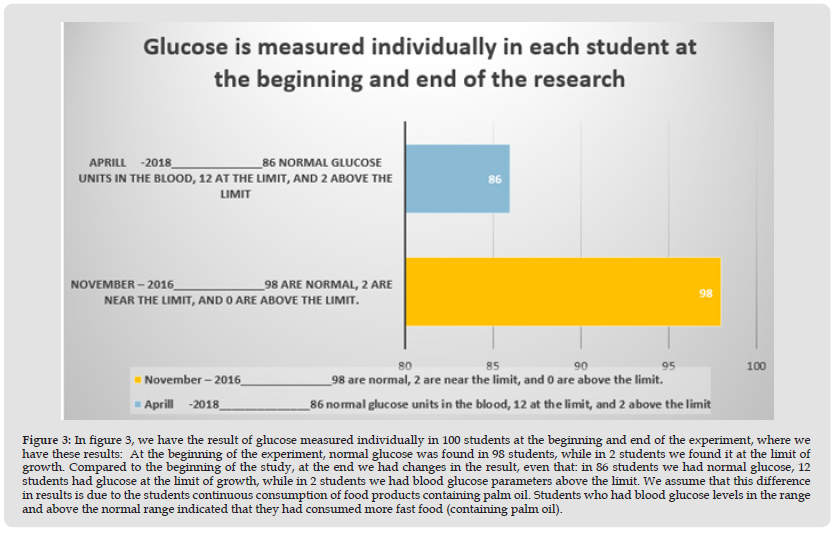Impact Factor : 0.548
- NLM ID: 101723284
- OCoLC: 999826537
- LCCN: 2017202541
Besim Memedi* and Nora Elshani
Received: April 11, 2023; Published: April 21, 2023
*Corresponding author: Besim Memedi, Alma Mater Europea Campus College ”Rezonanca” – Pristina
DOI: 10.26717/BJSTR.2023.49.007872
The use of palm oil increases every year [1-5]. The published facts show that there are differences in the composition of some types of palm oil, which determine and change the effects on the metabolism [1-2]. Obesity is a metabolic and multifactorial disease that causes complications such as type II diabetes, arterial hypertension, ischemic heart diseases, brain stroke, atherosclerosis, osteoarthrosis, various types of cancer (especially GIT), etc. According to the WHO, obesity is the pandemic of the 21st century [6]. Obesity occurs when energy from food is not used but it is deposited in fat tissue as a reserved energy source. More rarely, this is a consequence of endocrine gland secretion disorders (pituitary, gonads, thyroid, etc.), [7]. A child is said to be obese when he is above his normal weight to the extent that he puts himself at risk for various obesity-related diseases. The parameter that measures this weight is called the body mass index (BMI). If a child’s BMI is 30 kg/m2 greater than his norm, then he is called obese (fat child) [6].
Diabetes mellitus, or sugar diabetes is a serious disease of childhood and adolescence with serious complications for the patient, the family and the medical teams that care for him. Based on the classifications used nowadays, diabetes mellitus is divided into 2 main types, insulin-dependent diabetes and non-insulin-dependent diabetes. Type I - Insulin-Dependent Diabetes Mellitus (IDDM) is the most common form encountered in children and adolescents. In different countries, its prevalence is 1-2 cases per 1000 people of the same age. The peak incidence is reached at puberty, and new cases are mainly discovered in the cold months. IDDM it has a genetic basis. Damage to pancreatic β cells in predisposed children can be triggered by environmental factors such as viruses (parotitis, rubella, coxsackie), foods, exposure to some toxic substances, stress, etc. (Figure 1) Type II - Non-Insulin-Dependent Diabetes Mellitus ( NIDDM) it is rare in childhood and adolescence, in most cases, it begins in adulthood, over 40 years [8-11].
The purpose of this study is to learn the effects of food products containing palm oil, which adolescents (teenagers) use as fast food. At the same time to evaluate what damage and health risks are caused by these foods and whether they have a direct harmful effect on the obesity condition and pre-diabetes (Figure 2).
Figure 1 The first figure, shows the body weight result, where a significant difference can be seen between the beginning and end of the study. In students who have consumed foods containing palm oil more often, the increase in body weight is more noticeable compared to students who have not consumed every day palm oil containing foods.

Figure 2 In the second figure, we have presented the average concentration of glucose in the blood, which changed at the end of the study by increasing the parameters. At the beginning of the research, the average glucose was 5.2 mmol/l, while at the end of the study, the average glucose was 5.9 mmol/l. our assumptions say that this is due to the consumption of fast foods, which are mainly prepared with palm oil

The object of the research were 100 students of the secondary medical school in Gostivar, of whom 50 students were boys and the other 50 were female. Adolescent students were selected with different body weights. For this study we used scales for measuring the body weight of adolescent and glucometer (a device for measuring blood glucose levels). We measured the body weight of all students once a year, starting from October 2016 and ending in April 2018, whereas glucose levels were measured once at the beginning of the study and once at the end of the study. The foods used by adolescents that contained palm oil (even in small quantities) were also followed (Figure 3).
Figure 3 In figure 3, we have the result of glucose measured individually in 100 students at the beginning and end of the experiment, where we have these results: At the beginning of the experiment, normal glucose was found in 98 students, while in 2 students we found it at the limit of growth. Compared to the beginning of the study, at the end we had changes in the result, even that: in 86 students we had normal glucose, 12 students had glucose at the limit of growth, while in 2 students we had blood glucose parameters above the limit. We assume that this difference in results is due to the students continuous consumption of food products containing palm oil. Students who had blood glucose levels in the range and above the normal range indicated that they had consumed more fast food (containing palm oil).

At the beginning of the research, the average age of the adolescents was 16.08 years, the average height was 1.74 cm, the average body weight was 62.12 kg, and the body mass index was 23 kg/ m2, none of these students had diabetes.
From the research conducted, the results argue that palm oil increased body weight in students at the age of adolescence. The most important changes were observed in body weight, causing obesity of the first degree. The changes in blood glucose concentrations were slightly lower. We assume that teenagers (adolescents) who daily consume food products with palm oil are more predisposed to the appearance of obesity and pre-diabetic condition. If this age group of the population continues to consume such products constantly and continuously for a long time, then they will be at risk of developing diabetes.
Young teenagers (adolescents) are increasingly using fast foods that are high in palm oil. This requires finding and using effective strategies for healthy food as well as organizing media campaigns to promote young people not to consume such products that are harmful to the human body. Health personnel are also unfamiliar with these new scientific arguments. Therefore, our recommendation will be: to organize more scientific debates, seminars on the newest medical assumptions, and, above all, propaganda with health exhibitions in schools and relevant institutions about the harm caused by these food products.


